Exploring High Volume Irrigation Sprinklers in Detail
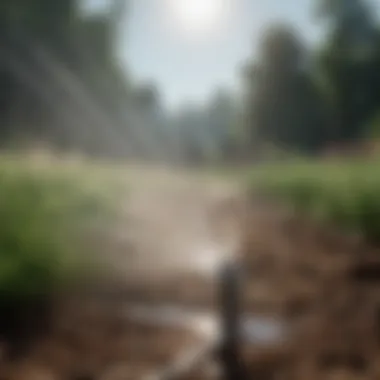
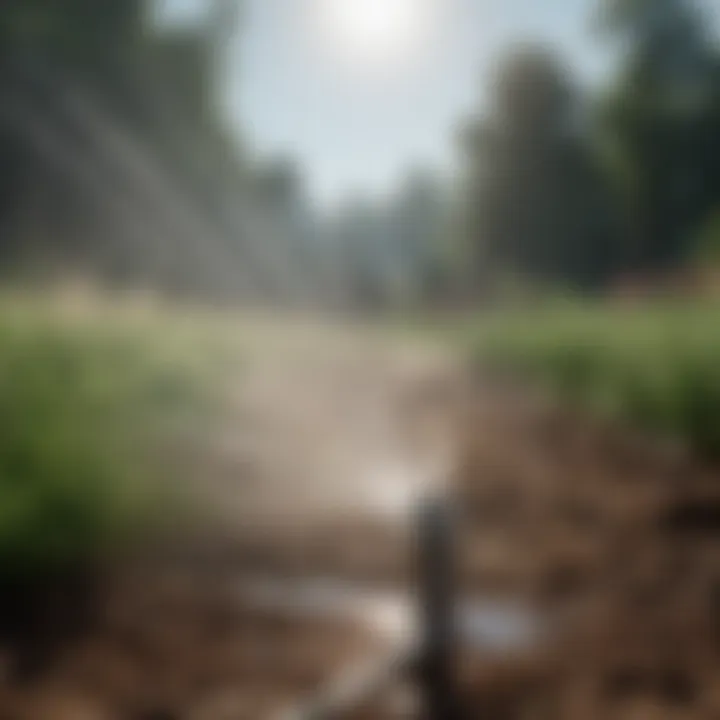
Intro
In today's rapidly changing global climate, effective water management has become a top priority for agriculture and many other sectors. High volume irrigation sprinklers are an essential part of this conversation, providing a means to deliver large amounts of water efficiently and effectively. Whether used on sprawling farmland, in parks, or for landscaping, understanding these systems is crucial for anyone involved with water usage.
Taking the plunge into the world of high volume irrigation, we unravel the various components, benefits, and limitations integral to these systems. With increasing pressures on water resources, knowing how these sprinklers work, their applications, and maintenance needs can set the stage for better water management practices.
This guide aims not only to educate students and professionals but also invites researchers and educators to reflect on the nuances of high volume irrigation. The balance between water conservation and agricultural productivity becomes vital as we explore these irrigation systems further.
Understanding High Volume Irrigation Sprinklers
High volume irrigation sprinklers play a vital role in modern agriculture and landscaping, catering to the pressing need for efficient water usage. As the demand for food increases globally, optimizing water resources has become more important than ever. This section dives into what defines high volume irrigation sprinklers, their types, and their significance in enhancing productivity while minimizing resource wastage.
To grasp the weight of this topic, it’s necessary to highlight that effective irrigation can drastically affect crop yields and overall resource management. These systems are designed not merely to wet the ground but to do so in a manner that promotes health and growth of the plants. Understanding how these systems work helps users choose the right type to meet their specific needs, ensuring they get the most from their investment.
Definition and Characteristics
High volume irrigation sprinklers, as the name suggests, are designed to deliver water at a much greater rate compared to traditional sprinklers. This means they can cover larger areas and provide more intensive water supply. Generally, they operate on principles of pressure and nozzle design to ensure a proportional distribution of water, effectively reaching crops that are spaced apart.
An essential characteristic of these sprinklers is the ability to adjust the spray pattern and range, which allows for customized coverage based on the landscape and crop situation. Moreover, there’s often a robustness to their design, enabling them to endure the rigors of outdoor use. They often come with features that facilitate ease of maintenance and performance adjustments, which makes them desirable for many agricultural applications.
Types of High Volume Sprinklers
High volume irrigation sprinklers are not one-size-fits-all. Instead, they come in various forms, each serving its particular niche within the wider agricultural context. Understanding these types helps in making informed choices.
- Impact Sprinklers
Impact sprinklers are characterized by their unique way of operation, which uses a spring mechanism to create an impact that rotates the sprinkler head. As a result, they are well-known for their efficiency in large spaces, making them a popular choice for farmers. Their flexibility allows for adjustments in the radius of the spray, making them capable of addressing diverse crop types. However, one drawback is that they may require a more extensive water pressure, which can be a concern in certain regions where water resources are limited. - Rotary Sprinklers
Rotary sprinklers often utilize a rotating head that provides a more consistent and evenly distributed water application. This feature reduces water wastage by ensuring coverage is uniform across the targeted area. The main advantage of rotary sprinklers lies in their energy efficiency and ability to handle variations in water pressure better than some other types. They can be suitable for both residential lawns and large agricultural fields and are lauded for their minimal maintenance needs. On the flip side, their effectiveness can be diminished in windy conditions since water droplets can be carried away, reducing the efficiency of irrigation. - Center Pivot Sprinklers
Center pivot sprinklers have revolutionized the way large fields are irrigated. They feature a rotating arm that moves around a pivot point, watering in a circular pattern. This system enables coverage of extensive areas with remarkable precision.
The standout advantage is the ability to automate irrigation schedules which can save both time and water. They are particularly useful in flat terrains and have become a staple in many large-scale farming operations. On the contrary, initial setup costs might be high, and they tend to be less effective on uneven land, necessitating careful planning of the layout.
Principles of Operation
Understanding the principles of operation behind high volume irrigation sprinklers is essential for optimizing their efficiency and effectiveness. These systems serve as the backbone of large-scale agricultural production, delivering vast quantities of water over extensive areas. Recognizing how sprinklers distribute water, as well as the dynamics of pressure and flow rate, equips practitioners with vital knowledge needed to leverage these technologies effectively.
Water Distribution Mechanics
Water distribution mechanics deal with how water is spread across a given area by irrigation sprinklers. The layout and design of a sprinkling system can significantly affect the uniformity of a water application. Take, for instance, an approach called "throw distance." This refers to how far the water travels after leaving the sprinkler head. Each type of sprinkler has its unique throw distance influenced by various factors including nozzle size, the height of the sprinkler, and operating pressure.
When planning a high volume irrigation layout, careful attention must be paid to the spacing of the sprinklers. If they are set too far apart, some areas may receive insufficient water while others might get drenched. This can lead to uneven growth of crops and wastage of resources. For instance, if one field has a mix of corn and soybeans, uneven watering can cause one crop to thrive while the other struggles.
To achieve optimal water distribution, farmers often conduct a pre-application evaluation that assesses soil type, crop water requirements, and environmental conditions. By establishing a precise irrigation plan, farmers can ensure that every inch of their field gets adequate coverage without overdoing it, leading to improved crop yields and conserving water.
Pressure and Flow Rate Dynamics
The relationship between pressure and flow rate is a critical aspect of irrigation systems. Basically put, pressure dictates the velocity of water that passes through the sprinklers. High pressure generally results in greater flow rates, which can enhance the efficiency of water application.
Each sprinkler has an optimal operating pressure range, and exceeding these values can cause unnecessary wear and tear. You see, when pressure is too high, it may lead to misting, where water evaporates before it even reaches the ground. On the flip side, if the pressure is too low, it can lead to inadequate coverage, requiring a longer application time or even leaving some areas dry.
A rule of thumb is to constantly monitor the pressure in the system. Including pressure gauges within the system allows farmers to make adjustments in real-time, ensuring the system works effectively. Many advanced systems are integrated with sensors that automatically adjust the pressure based on current conditions, which not only saves time but also reduces water wastage.
"An irrigator who understands the intricacies of pressure and flow can maximize efficiency while minimizing cost."
By understanding how pressure influences flow rates, farmers can tailor their irrigation strategies to fit specific crop needs and environmental conditions. This ultimately leads to better resource management and higher quality produce.
In summary, grasping the principles of operation for high volume irrigation sprinklers is key for effective agricultural practices. Focusing on the mechanics of water distribution and mastering pressure and flow dynamics will lead to greater efficiency and sustainability in irrigation efforts.
Benefits of High Volume Irrigation
High volume irrigation sprinklers bring numerous benefits that can significantly enhance agricultural practices and water management efforts. Understanding these advantages is crucial for those involved in farming and related sectors. This section delves into three key elements of high volume irrigation: efficient water utilization, support for large scale agriculture, and enhanced crop yield.
Efficient Water Utilization
One of the primary advantages of high volume irrigation is its capacity for efficient water utilization. Unlike traditional methods where water can be wasted through evaporation or runoff, high volume systems are designed to deliver water directly to the root zones of plants. This targeted approach reduces the overall quantity of water required, helping to conserve this precious resource.
- Reduced Waste: By applying water more effectively, excess runoff is minimized, which not only conserves water but also prevents nutrient leaching into surrounding environments.
- Adaptive Scheduling: Using moisture sensors and timers, these sprinklers can adapt to the specific needs of crops, watering them only when required. This ensures that water is not applied when it isn’t needed, further enhancing efficiency.
In practice, farmers who utilize high volume irrigation often report lower water bills and can allocate resources more effectively, leading to a more sustainable approach to farming.
Support for Large Scale Agriculture
When it comes to large scale agriculture, high volume irrigation systems are indispensable. Their capacity to cover extensive areas in a short amount of time allows farmers to manage their crops efficiently without extensive manual labor or oversight.
- Rapid Coverage: High volume systems can irrigate vast tracts of land quickly, which is particularly advantageous during peak growing seasons or in regions with unpredictable weather patterns.
- Labor Efficiency: By automating water distribution, farmers can redirect their efforts toward other important tasks such as crop monitoring and pest management.
This means that growers operating on large farms can maintain production levels without the continual hassle of irrigation management, ensuring their focus remains on maximizing productivity.
Enhanced Crop Yield
Lastly, one of the most compelling arguments for adopting high volume irrigation is the potential for enhanced crop yield. Proper irrigation directly influences plant health and productivity.
- Improved Plant Development: Consistent watering helps plants establish stronger root systems, which can resist drought stress and fend off diseases more effectively.
- Higher Profit Margins: With improved yields, farmers can increase their output without the corresponding rise in input costs, resulting in better profit margins per acre.
"Efficient irrigation not only boosts crop yield but ensures the longevity of the agricultural practice by conserving essential resources."
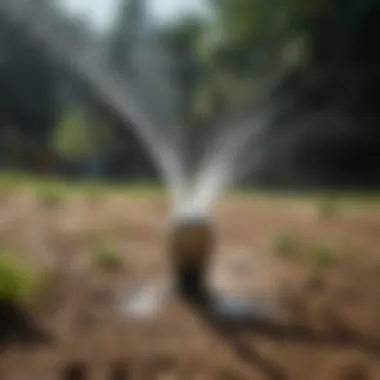
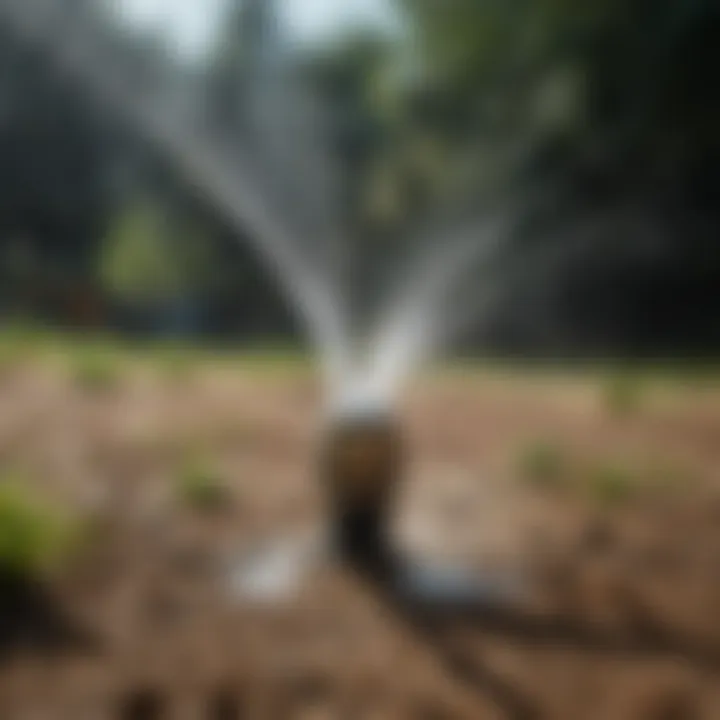
The interplay of moisture levels and crop growth leads to a direct correlation; better irrigation practices result in healthier and more robust plants. This ultimately means that high volume irrigation is not just a matter of convenience, but rather a strategic move towards agricultural success.
Limitations and Challenges
While high volume irrigation sprinklers offer a plethora of benefits, they are not without their downsides. Understanding these limitations is crucial for anyone considering their implementation in agricultural or landscaping practices. Addressing these challenges proactively can help in maximizing efficiency and sustainability. Let's delve into some key aspects that are vital in this discussion.
Initial Setup Costs
Setting up high volume irrigation systems is often not a walk in the park. The upfront costs can be significant. These expenses encompass a range of items, including equipment purchase, installation fees, and the necessary infrastructure to support the system. A farmer may find the initial investment daunting, particularly if they are transitioning from a traditional irrigation method. For example, purchasing a center pivot system could set one back tens of thousands of dollars, depending on the land size and specific needs. Moreover, the labor involved in setting up these systems adds further financial strain.
Many irrigation systems require specialized knowledge for proper installation and setup. Engaging professionals may diminish costs in some aspects but enhances the challenge budget-wise. While these costs seem hefty, it's essential to see them as an investment rather than just an expense. Over time, the efficiency gained can offset these initial expenditures.
Maintenance Requirements
Another hurdle to consider is the ongoing maintenance required for high volume irrigation sprinklers. Like anything in life, if you want it to function optimally, you need to take care of it. These systems require regular inspections and upkeep just to ensure they are working smoothly. Every season brings with it a checklist of maintenance tasks; clogged nozzles, damaged lines, and malfunctioning pumps can quickly put a wrench in the system.
Farmers need to allocate time and possibly funds for qualified personnel to perform maintenance checks and repairs.
To ensure a system runs efficiently, it’s helpful to develop a routine schedule.
- Inspect for clogs at least once per season.
- Check for leaks or any water wastage.
- Verify operational pressure is maintained.
This regular attention not only prolongs the lifespan of the system but also contributes to water conservation—something every farmer should keep in mind.
Environmental Concerns
The environmental implications of high volume irrigation must not be overlooked. A significant factor here is the water footprint these systems can leave—essentially a measure of water consumed versus efficiency. If not managed wisely, high volume watering can lead to over-irrigation, which can exacerbate issues such as soil salinization, erosion, and depletion of local water resources.
Moreover, the use of fertilizers and pesticides can be problematic with high-volume systems. Spraying large areas indiscriminately can lead to chemicals leaching into nearby water bodies, ultimately harming aquatic ecosystems.
It’s paramount to stay communicative with local regulations as well. These regulations are often put in place to promote sustainable practices. Adapting your irrigation approach not only meets compliance rules but also fosters goodwill within the community.
"It is not just about watering your crops; it's about watering them responsibly."
Considering these challenges is not merely a precaution; it’s a path forward. Acknowledging and addressing barriers fosters an environment of proactive decisions that can lead to more effective and environmentally friendly irrigation practices.
Design Considerations
When thinking about high volume irrigation sprinklers, it's essential to zero in on the design considerations that can make or break your irrigation project. Proper planning can lead to awe-inspiring benefits while avoiding potential pitfalls that could derail an otherwise viable irrigation strategy. Not only does thoughtful design address immediate agricultural needs, but it can also create a sustainable system to adapt to changing climate conditions.
Site Assessment and Planning
The heart of successful irrigation lies in understanding the land where the system will operate. Conducting a thorough site assessment is not just a trivial step but rather an integral part of the planning process. This entails looking at factors such as soil type, slope, existing vegetation, and even the proximity to water sources.
For instance, light sandy soils will retain less moisture compared to heavier clay types, which might dictate the frequency of watering needed.
- Soil Testing: It's vital to perform soil tests to analyze pH levels and nutrient content. This data tells you if there may be a need for additional fertilizers or other soil amendments.
- Topography: Mapping out the territory helps to understand how water will flow and if erosion might be an issue. A site with a significant slope might require additional considerations for runoff.
Proper planning can enhance efficiency as well, as it allows for better placement of sprinkler heads and pipelines. Engaging with a local expert can yield contextual insights, transforming your approach from guesswork to informed decision-making.
Selection of Sprinkler Type
Choosing the correct type of high volume sprinkler is like finding the right tool for a job; it's pivotal. Each type—be it Impact, Rotary, or Center Pivot—comes with its own strengths and weaknesses. Knowing what each offers lets you tailor your choice to specific landscape conditions and crop requirements.
- Impact Sprinklers: These are excellent for large fields. They bring flexibility in irrigation ranges and can be adjusted based on the area’s need.
- Rotary Sprinklers: More suited for varying terrain, they offer efficiency in water coverage while being cost-effective.
- Center Pivot Sprinklers: These are ideal for very large farms, efficiently covering vast areas while reducing labor costs.
In considering which type to go for, think about the size of the area to be irrigated, the type of crops being cultivated, and the available budget. A poor selection can lead to uneven watering, which ultimately harms crop yields.
Layout Configuration
Once the type of sprinkler has been chosen, the next step involves the layout configuration. This refers to how the sprinklers are arranged within the cultivated area. A well-planned layout not only maximizes coverage but also minimizes water wastage.
- Grid Layout: This configuration offers uniform distribution, particularly effective in square or rectangular fields. It often provides a good basis for evaluating performance.
- Contour Layout: Ideal for sloped terrains, this method involves laying out the irrigation in accordance with the land’s contours, thereby aiding in capturing runoff without leading to erosion.
- Alternate Row Layout: A practical choice for fields with diverse crops; this allows irrigation to be customized according to the specific needs of certain plants.
A configuration that considers the layout helps in reducing the chances of overlap, which can lead to pooling in some areas and scarcity in others.
In summary, a thorough approach to design considerations in high volume irrigation systems can have substantial implications for both efficiency and sustainability. \
Getting these elements right saves time and resources, putting you on a solid path to successful and fruitful irrigation efforts.
Maintenance Best Practices
Maintaining high volume irrigation sprinklers is no small feat. Just like a well-tuned engine needs regular checks to run smoothly, these systems require diligent care to ensure they function efficiently. Proper maintenance not only extends the lifespan of the equipment but also optimizes water usage and promotes healthy crop growth. This is particularly crucial in agricultural contexts, where every drop counts. Neglecting maintenance can lead to inefficiencies that cost time and resources. Thus, understanding best practices becomes essential in the realm of high volume irrigation.
Regular Inspection Routines
A routine inspection can save a world of trouble down the road. Establishing a schedule for regular checks ensures that any potential issues can be spotted before they escalate. Here are some key aspects to focus on during inspections:
- Visual Checks: Regularly look for physical damage to pipes, connectors and sprinklers. A small crack can lead to significant water loss.
- Flow Rate Monitoring: Keep an eye on how much water is being distributed. Variations might signal blockages or malfunctions.
- Pressure Tests: Maintain optimal pressure levels. Low pressure could indicate leaks or clogs, while high pressure may lead to joint failures.
"An ounce of prevention is worth a pound of cure." This old saying rings particularly true when it comes to irrigation system maintenance.
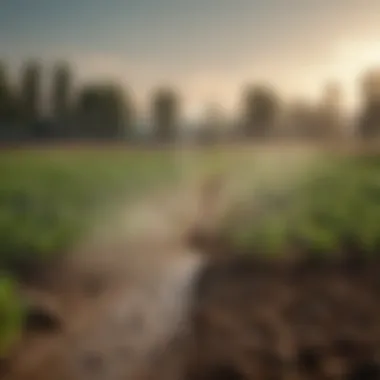

Troubleshooting Common Issues
Even with the best maintenance practices, problems can occasionally crop up. Identifying and addressing issues quickly can prevent more significant problems from developing. Here’s a breakdown of common issues and their possible solutions:
- Clogged Nozzles: If water isn’t spraying as it should, it’s time to check for clogs. Cleaning or replacing the nozzle often resolves this issue.
- Uneven Distribution: If water is pooling in one area while another remains dry, there could be a misalignment. Adjusting the sprinkler heads may help.
- Leakages: Identify if there are leaks in pipes or at junctions. Regularly checking seals and connectors can minimize this problem.
Seasonal Maintenance Guidelines
Different seasons present unique challenges for irrigation systems. Being adaptable and proactive can pay huge dividends. Here are some seasonal guidelines to bear in mind:
- Spring: Before turning systems on for the season, conduct a full inspection. Repair any winter damage.
- Summer: Watch for buildups of debris; this is particularly critical for systems dealing with heavy foliage.
- Fall: Prepare systems for winter by draining water to prevent freezing. Check any winterization protocols necessary for your area.
- Winter: Inspect systems during downtime to ensure everything is intact for the start of the next season. Regular checks will ensure everything remains in top shape.
By employing these maintenance best practices, users can expect not just a reliable system, but one that maximizes water efficiency, promoting better crop yields and sustainable practices in the long run.
Regulatory Compliance
Understanding regulatory compliance in high volume irrigation is essential for ensuring that systems operate within the legal framework, protecting both the environment and agricultural productivity. These regulations can dictate water usage limits, methods of irrigation, and the impact on surrounding ecosystems. Compliance not only safeguards resources but also enhances the reputation of operations, ultimately benefiting stakeholders and communities.
Water Usage Regulations
Water usage regulations are the backbone of sustainable irrigation practices. These laws vary by region, reflecting local climate conditions, water availability, and governmental policies. For instance, in California, strict rules have been in place to conserve water in agriculture due to chronic drought conditions. Here are some key considerations regarding water usage regulations:
- Permits and Licenses: Farmers often need permits to use specific quantities of water, especially from shared sources like rivers.
- Usage Tracking: Many regions require the installation of meters to monitor water use effectively. This data can help in regulatory reporting and consumption analysis.
- Seasonal Limitations: Some areas impose restrictions on water use during dry seasons to avoid over-extraction and ensure fair distribution among users.
Non-compliance with these regulations can lead to hefty fines and could even result in the suspension of irrigation rights. Thus, understanding these rules is not just a matter of legality; it's also about sustainable farming practices that can affect long-term viability.
Environmental Impact Assessments
Environmental Impact Assessments (EIAs) are a critical aspect for anyone implementing high volume irrigation technologies. They gauge the potential effects of proposed irrigation methods on local ecosystems. In many places, before the installation of sprinklers, farmers might be required to submit an assessment, detailing how their operation might affect soil quality, local flora and fauna, and water bodies.
Importance of EIAs includes:
- Preventing Degradation: By analyzing possible outcomes, farmers can take proactive steps to mitigate adverse effects, such as maintaining riparian buffers around water sources.
- Community Trust: Engaging in EIAs builds trust with the community and fosters good relationships with local environmental agencies.
- Financial Incentives: Sometimes, compliance with EIA requirements can unlock funding opportunities, whether from government initiatives or private investors.
In some countries, such as Australia, an EIA is mandatory for any project deemed capable of having a significant environmental impact. This regulatory framework assists in preventing ecological harm while promoting sustainable agricultural practices.
There’s an old saying: "If you don’t know where you’re going, any road will take you there." Hence, navigating the complex landscape of regulatory compliance is not just a checklist; it’s a roadmap for responsible irrigation management.
Technological Innovations in Sprinkler Systems
In the realm of agriculture and landscaping, technological advancements are not just adding bells and whistles; they are transforming the very foundation of how we approach irrigation. High volume irrigation sprinklers, long known for their ability to deliver substantial water supply efficiently, are now integrating cutting-edge technologies that enhance their effectiveness and reduce waste. These innovations are essential not only for maximizing water usage but also for ensuring the sustainability of agricultural practices.
Incorporating smart technologies into traditional systems provides various benefits, from optimized water delivery to real-time monitoring of environmental conditions. Let's delve deeper into some remarkable innovations.
Smart Irrigation Technologies
The advent of smart irrigation technologies marks a pivotal shift in how water resources are managed. These technologies leverage data-driven insights to operate sprinklers more effectively. For instance, automatic scheduling systems can adjust irrigation times based on local weather forecasts, significantly cutting down on water waste during rainy days.
This not only promotes environmental sustainability but also leads to considerable cost savings for farmers and gardeners alike. Smart irrigation systems can be programmed to monitor factors such as soil moisture levels, temperature, and even atmospheric humidity. This way, sprinklers operate only when necessary, preventing over-saturation and promoting healthier plant growth.
Some examples include:
- Soil Moisture Sensors: These devices measure the moisture content in the soil, allowing users to adjust watering schedules accordingly.
- Climate Smart Controllers: These advanced controllers can process local weather information to optimize when and how much water to apply.
- Mobile Apps and Interfaces: Many of these technologies come equipped with applications that let the user monitor and control their irrigation system remotely.
Sensor Integration for Efficiency
Sensor technology is the backbone of modern high volume irrigation systems. Integrating various sensors into the irrigation framework allows for a seamless response to the changing needs of crops and landscape features.
With sensors installed throughout the irrigation system, data gathered can lead to more tailored watering solutions. For example, pressure sensors can identify blockages or leaks in the system, maintaining proper water flow while reducing wastage. Moreover, integrating temperature sensors can help in forecasting plant water needs based on heat conditions.
Furthermore,
"Integration of sensor networks within irrigation systems helps in creating a feedback loop that informs necessary changes dynamically, making systems responsive rather than reactive."
The outcomes of these integrated systems can be quite striking:
- Improved Resource Management: Reducing over or under-watering directly impacts crop yield and health.
- Sustaining Water Resources: With a keen eye on wastage, farms can practice more sustainable agriculture, preserving water for future generations.
- Enhanced Operational Efficiency: Time spent manually monitoring irrigation is significantly decreased, allowing farmers to focus on other important tasks.
Comparative Analysis with Other Irrigation Methods
Analyzing high volume irrigation systems alongside other irrigation methods is crucial for understanding their role in modern agriculture. This comparison helps determine the most efficient and effective ways to allocate water resources, ensuring that farmers and land managers make informed choices. When looking at high volume irrigation, it’s key to consider not just how it functions but how it stacks up against alternatives like drip watering and flood irrigation.
Drip Irrigation vs. High Volume Sprinklers
Drip irrigation employs a vastly different approach compared to high volume sprinklers. This method delivers water directly to the plant's roots through a network of tubes and emitters. Here’s a quick breakdown:
- Water Efficiency: Drip irrigation is often touted as the champion of water efficiency, using approximately 30-50% less water than traditional sprinkler systems. This is particularly vital in regions where water scarcity is a pressing issue. High volume sprinklers, while using more water, can be advantageous in covering large areas quickly.
- Targeted Delivery: Drip systems ensure that water is precisely where it’s needed, which can foster healthier plants and reduce weed growth since water isn't spread indiscriminately.
- Installation and Maintenance: Setting up drip irrigation can be labor-intensive and necessitates a bit of technical know-how, particularly in planning the layout to ensure even distribution. Conversely, high volume sprinklers are simpler to install and require comparatively less maintenance.
- Soil Type Compatibility: Some soil types, particularly sandy soils, benefit more from drip irrigation as it minimizes water runoff. High volume sprinklers can lead to pooling and runoff if not managed correctly, especially on sloped terrains.
In many cases, the choice between using drip irrigation and high volume sprinklers boils down to factors such as crop type, local climate, and economic considerations.
Flood Irrigation Insights


Flood irrigation, one of the oldest practices, floods the fields with water, allowing it to seep into the soil. It’s worth noting that while this approach has its niche, especially in areas with certain soil types and crops like rice, it seems somewhat clunky when compared with more advanced methods. Here's what to consider:
- Water Usage: Surprisingly inefficient compared to sprinklers or drip systems, flood irrigation can waste up to 50% of the water used due to evaporation and runoff.
- Labor and Management: Managing flood irrigation can be more laborious. It requires careful timing and monitoring to make sure crops aren’t submerged for too long, which can be detrimental.
- Nutrient Distribution: Flooding can lead to uneven distribution of nutrients in the soil, as water moves through the earth’s surface, potentially washing away valuable topsoil and fertilizers.
- System Resilience: Interestingly, flood irrigation might seem less sophisticated, yet in some cases, it can be more resilient under certain environmental conditions, especially where initial setup costs can be offset by abundant local water availability.
In the grand scheme, while high volume sprinklers offer flexibility and rapid coverage, understanding their limitations and comparing them with methods like drip and flood irrigation enables farmers to devise a water management strategy that aligns with their operational goals and environmental responsibilities.
"Water is the driving force of all nature." - Leonardo da Vinci
From this analysis, it becomes clear that the choice of irrigation method should be rooted in a thoughtful consideration of both immediate needs and long-term sustainability objectives.
Case Studies in Irrigation Systems
Exploring case studies in irrigation systems serves as a critical piece in understanding high volume irrigation sprinklers. These real-world examples highlight the applied techniques, practices, and lessons gleaned from various implementations. By reviewing diverse case studies, individuals—including students, researchers, and professionals—can uncover best practices and identify potential pitfalls within specific contexts. Case studies are not just informative; they also provide a narrative that guides continuous improvement in irrigation methods while showcasing the adaptability and relevance of technology in various climates and agricultural setups.
Successful Implementations
Successful implementations of high volume irrigation systems can be found in numerous agricultural settings, demonstrating both efficiency and enhanced productivity. For instance, a farmer in California recently installed center pivot sprinklers across his expansive crop fields. Within a single growing season, yields of corn saw a boost of nearly 25%. This operation benefitted not only from efficient water distribution but also from uniform coverage that minimized waste and increased the health of the crops.
Some key benefits of these successful applications include:
- Increased Yield: The boost in crop yields often translates into more considerable profits and food supply stability.
- Water Efficiency: High volume systems can deliver water evenly, reducing drought stress on plants, especially during critical growth phases.
- Adaptability: Certain systems, such as mobile irrigators, allow farmers to change configurations based on seasonal needs.
Another remarkable implementation can be observed in Spain, where impact sprinklers were used to irrigate olive groves. The farmer reported a reduction in water usage by approximately 30% compared to traditional methods. This not only helped economically but also aligned with sustainability goals. The results speak to the practical benefits that come from thoughtfully designed irrigation systems, where the right technology is harnessed according to specific agricultural needs.
Lessons Learned from Failures
On the flip side, there have been failures that are equally instructive, albeit less uplifting. A notable case involved the installation of rotary sprinklers in a vineyard in Australia, which did not yield the expected results. Despite initial optimism, several factors contributed to this setback:
- Insufficient Water Pressure: The design did not account for varying elevations, leading to uneven water distribution that harmed grape quality.
- Poor Maintenance: Inadequate upkeep resulted in clogging and breakdowns. This experience demonstrates that technical installations require continuous attention to detail.
- Environmental Misalignment: The system was ill-suited to the local climate, resulting in over-watering during rain seasons.
"Learning from failure is as valuable as celebrating success; it can lead to better irrigation practices and technology adaptations."
Each mistake serves as a guiding light for future projects. Keeping a pulse on the lessons derived from these less-than-ideal scenarios informs decision-making and project planning. In sum, the exploration of both successful and failed case studies presents a robust framework from which to draw validation for future implementations of high volume irrigation systems, ensuring that individuals can navigate their own endeavors with a sharper lens toward productive outcomes.
Future Trends in Irrigation Technology
As we dive deeper into the realm of agriculture, the future of irrigation technology becomes paramount in addressing several challenges we face today. Efficient water management systems are vital, especially with climate change and population growth straining resources. Future innovations address both the environmental impacts and the need for increased efficiency in crop production.
Sustainable Practices and Innovations
Sustainability is the keyword in modern agriculture. The ongoing innovations focusing on sustainable irrigation practices are essential for conserving water while maintaining productivity.
- Rainwater Harvesting: Collecting and storing rainwater for irrigation purposes not only reduces dependency on groundwater but also mitigates water runoff. Farmers have turned their attention to roofs and surfaces for capturing this precious resource.
- Drip Irrigation Advances: While drip systems have been around for some time, recent advances have led to new designs that enhance efficiency. These systems now integrate smart sensors that help deliver the right amount of water at the right time, based on real-time data from soil moisture levels.
- Recycled Water Utilization: More farms are now utilizing treated wastewater for irrigation. This innovation supports sustainability by helping replenish water supplies and decreasing the burden on freshwater sources.
Implementing these sustainable practices not only benefits the environment but also enhances crop yield and quality over time, making it a win-win situation for the agriculture sector.
Adaptive Technologies for Varying Climates
The diversity in climatic conditions across regions poses significant challenges to traditional irrigation systems. Hence, developing adaptive technologies is crucial.
- Smart Climate Monitoring: Using sophisticated meteorological tools, farmers can monitor changing weather patterns and adjust irrigation schedules accordingly. This proactive approach prevents both under and over-irrigation.
- Soil Health Management: Emphasis on technologies that assess soil health can lead to more tailored irrigation strategies. For example, sensors can provide precise data on nutrient levels and moisture content, allowing for targeted interventions.
- Variable Rate Irrigation: This technology allows irrigation equipment to adjust the water application rate based on specific field conditions, which can vary from one area to another. By targeting regions in need of greater water input, this practice optimizes resources and reduces waste.
"The advancements in adaptive technologies not only aim to utilize water more efficiently but also help farmers respond to unpredicted changes in weather, ensuring agricultural resilience."
By incorporating these adaptive technologies, farmers can enhance their resilience against climate fluctuations, ensuring that agriculture remains viable even in the face of adverse conditions.
In summary, as we look to the future, high-volume irrigation will undoubtedly evolve with these trends in sustainable practices and adaptive technologies. The result is a more efficient and resilient agricultural landscape, essential to meet the world's food demands.
End
High volume irrigation sprinklers play a crucial role in modern agricultural practices and effective water management. As pressures on global water resources escalate, understanding these systems becomes ever more important. This section wraps together some key themes explored in the article, including the technical operation, advantages, limitations, and innovations paving the way for the future of irrigation.
By using high volume irrigation systems, farmers can enhance crop yield while simultaneously working towards efficient water usage. One of the standout features is their capacity to cover large areas quickly, making them particularly beneficial for extensive agricultural fields. This efficiency not only maximizes productivity but also minimizes labor costs associated with manual irrigation. The previously mentioned technologies, such as smart irrigation, further optimize these systems by ensuring precise water delivery based on real-time data.
Nevertheless, every coin has two sides. The article has shown that while the advantages are substantial, challenges persist, such as initial setup costs and ongoing maintenance requirements. It is imperative for practitioners to weigh these pros and cons carefully.
Take into account:
- Initial Costs: High volume sprinkler systems often require a significant upfront investment.
- Regular Maintenance: Regular checks and troubleshooting are essential to keep the systems functioning as intended.
- Environmental Concerns: Ensuring that these systems are used sustainably is vital for minimizing negative effects on local ecosystems.
In summary, the successful implementation of high volume irrigation sprinklers hinges on informed choices, careful planning, and ongoing vigilance. Understanding these aspects is imperative not just for optimizing performance but also for ensuring sustainable practices that can meet future demands.
Summary of Key Insights
Examining the extensive applications of high volume irrigation revealed several noteworthy insights:
- Efficiency in Water Use: Their design allows for rapid watering across expansive fields, thereby conserving water.
- Variety of Types: Different irrigation types cater to various agricultural needs, from impact to center pivot systems.
- Technology Integration: Innovations in smart technology provide a new frontier in irrigation, enhancing the effectiveness of these systems.
- Balancing Costs and Benefits: Understanding cost versus output remains a perennial challenge but is fundamental for making informed decisions.
By fostering a deeper comprehension of these elements, stakeholders can better navigate the complexities of implementing high volume sprinklers in their operations.
Final Thoughts on High Volume Irrigation
Looking to the future, high volume irrigation sprinklers stand as a testament to how technology and agriculture can intertwine. The continuing evolution of these systems—marked by improved efficiency and sustainability—offers hope for addressing the modern challenges of global food production and water scarcity.
Engaging with current trends and being open to integrating new technologies consistently comes back to the essential question: How can we better our practices without overburdening resources?
In the grand scheme, high volume irrigation is not just about watering crops; it's about cultivating a mindset toward sustainability, efficiency, and innovation. Anyone involved in this field has a role to play in this ongoing dialogue, whether it's through practices that limit water waste, adopting smarter tech solutions, or even pushing toward regulatory changes that help balance agriculture needs with ecological responsibilities. It's time to take the lessons learned and apply them, ensuring that future generations can enjoy the benefits of these irrigation systems.



